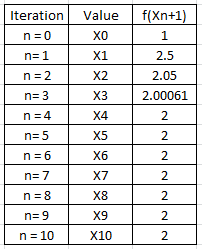
Interpretation:
Using Newton’s method, consider the map xn+1 = f(xn), where f(xn) = xn- g(xn)g'(xn), and write Newton’s map xn+1 = f(xn) for the equation g(x) = x2−4=0. Show that Newton’s map has the fixed points at x&*#x00A0;= ±2. Show that the fixed points are superstable. Also, iterate the map numerically from x0=1 and notice the rapid convergence.
Concept Introduction:
➢ Obtain Newton’s map from the given function
➢ Determine the fixed points for the given equation and its stability.
➢ Iterate and calculate the numerical values of the function.
Answer to Problem 12E
Solution:
a) The Newton’s map is f(xn) = (xn)2+42xn for the given equation g(x) = xn2−4
b) It is shown that the fixed points for the given equation are x&*#x00A0;= ±2
c) It is shown that the fixed points x&*#x00A0;= ±2 are super stable points.
d) The iteration map with numerical values is shown and f(x) converges rapidly to f(x) =2.
Explanation of Solution
In the given Newton’s method, consider the map
xn+1 = f(xn),
where f(xn) = xn- g(xn)g'(xn)
Here xn+1 is the iteration equation for the function.
The function equation is f(xn) and its derivative is f '(xn)
a) The Newton map
xn+1 = f(xn),
where f(xn) = xn- g(xn)g'(xn)
As per given, g(x) = xn2−4=0
And it’s derivative g'(x) = 2x
Newton’s map is calculated by substituting g(x) and g'(x)
f(xn) = xn- g(xn)g'(xn)
f(xn) = xn- xn2−42xn
f(xn) = 2(xn)2−(xn)2+42xn
f(xn) = (xn)2+42xn
Hence Newton’s map is f(xn) = (xn)2+42xn for the g(x) = xn2−4
b) The fixed points of Newton’s map are calculated as,
x&*#x00A0;= xn+1
x&*#x00A0;= xn
By substituting the value in the equation x&*#x00A0;= f(xn) and x&*#x00A0;= xn
xn+1 = f(xn)
x&*#x00A0;= (x*)2+42x*
2(x*)2 = (x*)2+4
(x*)2 = 4
x&*#x00A0;= ±2
Hence the fixed points for the given equation x&*#x00A0;= ±2
c) The stability of the system is determined as below,
Consider the function f(x) = xn+1
f(xn) =xn2+42xn
The derivative of function f '(xn) is shown below,
f '(xn) =2xn(2xn)−2(xn2+4)(2xn)2
f '(xn) =4(xn)2−2(xn)2−84(xn)2
f '(xn) =2(xn)2−84(xn)2
f '(xn) =(xn)2−42(xn)2
Now substituting the fixed points x&*#x00A0;= ±2 in f '(xn)
f '(±2) =(xn)2−42(xn)2=(±2)2−42(±2)2=0
Hence the fixed points x&*#x00A0;= ±2 are super stable points.
d) As we iterate the map numerically as shown below, starting from the initial value x0= 1,
f(xn) = (xn)2+42xn
By substituting the initial value
f(x1) =(x0)2+42(x0) =(1)2+42(1)=2.5
Similarly f(x2) =(x1)2+42(x1) =(2.5)2+42(2.5)=2.05
f(x3) =(x2)2+42(x2) =(2.05)2+42(2.05)=2.0006
The iteration of the map and numerical values of the function is given below in tabular form for the initial value of x0=1. From the observed values, f(x) converges rapidly and the exact solution for the given function is f(x) =2.

Want to see more full solutions like this?
Chapter 10 Solutions
EBK NONLINEAR DYNAMICS AND CHAOS WITH S
- In Exercises 1-14, state whether each statement is true or false. If false, give a reason. 1. The set of stores located in the state of Wyoming is a well- defined set. 2. The set of the three best songs is a well-defined set. 3. maple = {oak, elm, maple, sycamore} 4{} cơ 5. {3, 6, 9, 12,...} and {2, 4, 6, 8, ...} are disjoint sets. 6. {Mercury, Venus, Earth, Mars} is an example of a set in roster form. 7. {candle, picture, lamp} = {picture, chair, lamp } 8. {apple, orange, banana, pear} is equivalent to {tomato, corn, spinach, radish}.arrow_forwardExercises Evaluate the following limits. 1. lim cot x/ln x +01x 2. lim x² In x +014 3. lim x* x0+ 4. lim (cos√√x)1/x +014 5. lim x2/(1-cos x) x10 6. lim e*/* 818 7. lim (secx - tan x) x-x/2- 8. lim [1+(3/x)]* x→∞0arrow_forwardIn Exercises 1 through 3, let xo = O and calculate P7(x) and R7(x). 1. f(x)=sin x, x in R. 2. f(x) = cos x, x in R. 3. f(x) = In(1+x), x≥0. 4. In Exercises 1, 2, and 3, for |x| 1, calculate a value of n such that P(x) approximates f(x) to within 10-6. 5. Let (an)neN be a sequence of positive real numbers such that L = lim (an+1/an) exists in R. If L < 1, show that an → 0. [Hint: Let 1111 Larrow_forward
- iation 7. Let f be continuous on [a, b] and differentiable on (a, b). If lim f'(x) xia exists in R, show that f is differentiable at a and f'(a) = lim f'(x). A similar result holds for b. x-a 8. In reference to Corollary 5.4, give an example of a uniformly continuous function on [0, 1] that is differentiable on (0, 1] but whose derivative is not bounded there. 9. Recall that a fixed point of a function f is a point c such that f(c) = c. (a) Show that if f is differentiable on R and f'(x)| x if x 1 and hence In(1+x) 0. 12. For 0 л/2. (Thus, as x л/2 from the left, cos x is never large enough for x+cosx to be greater than л/2 and cot x is never small enough for x + cot x to be less than x/2.)arrow_forward1. Show that f(x) = x3 is not uniformly continuous on R. 2. Show that f(x) = 1/(x-2) is not uniformly continuous on (2,00). 3. Show that f(x)=sin(1/x) is not uniformly continuous on (0,л/2]. 4. Show that f(x) = mx + b is uniformly continuous on R. 5. Show that f(x) = 1/x2 is uniformly continuous on [1, 00), but not on (0, 1]. 6. Show that if f is uniformly continuous on [a, b] and uniformly continuous on D (where D is either [b, c] or [b, 00)), then f is uniformly continuous on [a, b]U D. 7. Show that f(x)=√x is uniformly continuous on [1, 00). Use Exercise 6 to conclude that f is uniformly continuous on [0, ∞). 8. Show that if D is bounded and f is uniformly continuous on D, then fis bounded on D. 9. Let f and g be uniformly continuous on D. Show that f+g is uniformly continuous on D. Show, by example, that fg need not be uniformly con- tinuous on D. 10. Complete the proof of Theorem 4.7. 11. Give an example of a continuous function on Q that cannot be continuously extended to R. 12.…arrow_forwardcan I see the steps for how you got the same answers already provided for μ1->μ4. this is a homework that provide you answers for question after attempting it three triesarrow_forward
- 1. Prove that for each n in N, 1+2++ n = n(n+1)/2. 2. Prove that for each n in N, 13 +23+ 3. Prove that for each n in N, 1+3+5+1 4. Prove that for each n ≥ 4,2" -1, then (1+x)" ≥1+nx for each n in N. 11. Prove DeMoivre's Theorem: fort a real number, (cost+i sint)" = cos nt + i sinnt for each n in N, where i = √√-1.arrow_forwardPls help ASAParrow_forward2. Sam and Deb have a weekly net income of $1500. They have a pet dog. Their monthly expenses, not related to housing, are $2875. They have savings of $32 000. They are considering two housing options: Option 1: Renting a 2-bedroom condo for $1650 a month, plus utilities averaging $210 a month Option 2: Buying a 2-bedroom condo for a down payment of $24 500, bi-weekly mortgage payments of $1100, and a monthly condo fee of $475 a) Determine the monthly cost of each housing option. Factoring in other expenses not related to housing, which one can Sam and Deb afford? b) Suppose their dog falls ill and they have to pay $85 every week to cover veterinarian and medical expenses. Calculate the additional monthly expenses. How much money would be available for savings if they choose housing option 2?arrow_forward
- I bought sparrows at 3 for a penny, turtle doves at 2 for a penny, anddoves at 2 pence each. If I spent 30 pence buying 30 birds and boughtat least one of each kind of bird, how many birds of each kind did I buy?(This is a problem from Fibonacci’s Liber Abaci, 1202.)arrow_forward2. Jacob is going to college. He has a part-time job with take-home pay of $575 every two weeks. He has received a scholarship for $5500 for the year. Determine Jacob's total monthly income.arrow_forward1. Pira's expenses are $850 a month for rent and utilities, $52 a month for TV and Internet package, $90 a week for food, $110 a month for a bus pass, $25 a week for entertainment, and $85 every two weeks for miscellaneous expenses. a) Convert each expense to a monthly amount and represent each monthly amount as a percentage. b) Create a circle graph that shows the breakdown of the monthly expenses. c) Pira has an income of $1600/biweekly and is deciding whether a weeklong vacation to Florida would be within her budget. The cost of the trip is approximately $2000 per week. Would you recommend for her to take the one weeklong vacation? Explain.arrow_forward
- Algebra & Trigonometry with Analytic GeometryAlgebraISBN:9781133382119Author:SwokowskiPublisher:Cengage
